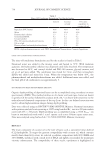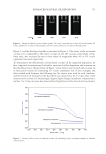705 UV OXIDATION From these data, a reaction scheme can be proposed (Scheme 3) for possible pathways following the excitation of tyrosine by UV irradiation. Multiple pathways are involved, but it has been shown that redox metals, such as iron, and oxygen play an important role in degradation and antioxidants such as BHT can intercept at least some of these pathways. This information identifies several strategies for potentially reducing UV-induced oxidative damage in hair. The first is the removal of redox metals to prevent the acceleration of radical formation, as shown in Scheme 3. This strategy has been demonstrated to be successful in the case of copper removal (27). The second is through the addition of antioxidants that can scavenge the ROSs formed. The literature on wool has indicates success with this strategy in protecting wool from photoyellowing (28). More recently, botanical extracts that have traditionally been used as antioxidants in food have also been shown to provide benefits to hair. Protein protection has been measured for artichoke (Cynara cardunculus var. scolymus L.) and rice grain (Oryza sativa L.) extracts (29). However, none of these studies included an analysis of extract compositions or a correlation between the antioxidant activity of these botanical extracts and the prevention of hair damage. Table II Effect of BHT at Low Concentration on Tyrosine Degradation Over 24 h in 0.172 mM PEG2000–Tyr5 Micellar Systems Degradation (%) System No BHT 0.05 mM BHT Suppression by antioxidant No metal 16.7 5.9 64.7 0.5 ppm Fe(stearate)3 28.0 26.6 5.0 0.5 ppm Fe(acac)3 66.0 22.4 66.1 Scheme 3. Summary of tyrosine degradation in model systems. Oxygen-dependent pathways are shown in blue the involvement of iron is shown in red.
706 JOURNAL OF COSMETIC SCIENCE TEA EXTRACTS In this work, tea (C sinensis) was the chosen botanical antioxidant to test its ability to scavenge reactive oxygen species in the presence of UV radiation. It is rich in polyphenols and has been shown to deliver benefits to both skin and hair (10). Several publications have studied the use of tea extracts as protection against UV-induced skin damage and in the development of sunscreen products (11,30). Tea extracts have also been studied for their impact on hair growth (12) and sebum reduction (13). In an earlier study, 16 tea extracts were chosen, and their antioxidant abilities were tested by ORAC assay (31). This assay is commonly used to measure the antioxidant capacities of foods such as teas, fruits, and vegetables, and it measures inhibition of peroxyl-radical-induced oxidations by the hydrogen-atom-transfer mechanism, a mechanism relevant to human biology and hair. The azo initiator 2,2′-azobis(2-amidinopropane) dihydrochloride is used to generate peroxyl radicals, and a fluorometer is used to measure the rate at which the formed radicals oxidatively degrade an added fluorescent molecule (fluorescein). Table III reports the ORAC data from the 16 tea samples tested and shows that the ORAC scores ranged over three orders of magnitude from 92 to 3,413,500 μM Trolox™ equivalents (TE). Liquid chromatography/mass spectrometry was used to measure the compositions of the 16 tea samples, and a total of 42 compounds were detected, of which 34 were identified full details of the compounds identified are available in Davis et al. (31). The majority of extracts contained low levels of all compounds, with the exception of the four tea samples with BICs 29455, 29458, 29462, and 29465. These four extracts contained similar profiles Table III ORAC Scores for C sinesis (Tea) Extracts* BIC Tea type Form Delivery ORAC score (μM TE/100 g) Standard deviation 29465 Green Powder Made up to 5% 3,413,500 241,123 29458 Green Powder Made up to 5% 1,897,076 45,142 29455 Green Powder Made up to 5% 1,500,536 49,262 29462 Green Powder Made up to 5% 1,454,008 181,366 29459 Green Liquid 10–25% in propylene glycol 108,702 40,091 29471 Green Powder 5% with maltodextrin 71,797 10,341 29464 Green Liquid Unknown conc. in glycerin 46,920 2,969 29463 White Liquid 10% in propylene glycol 42,635 7,840 29469 Green Liquid 5% in glycerin 40,580 23,079 29457 Green Liquid 5% in glycerin 22,861 6,554 29467 White Liquid Unknown conc. in propylene glycol 15,098 2,303 29470 White Liquid Unknown conc. in glycerin 7,980 654 29460 Green Liquid Unknown conc. in glycerin 3,028 62 29456 White Liquid Unknown conc. in glycerin 1,747 174 29466 White Liquid Unknown conc. in glycerin 1,025 186 29461 White Liquid Unknown conc. in glycerin 92 13 *Reproduced with permission from Scientific Research Publishing, Inc. (31).
Purchased for the exclusive use of nofirst nolast (unknown) From: SCC Media Library & Resource Center (library.scconline.org)






































































































































